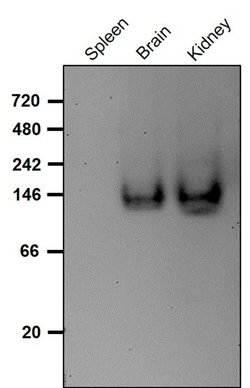Learn More
Invitrogen™ Sall1 Monoclonal Antibody (NRNSTNX), eBioscience™


Rat Monoclonal Antibody
Supplier: Invitrogen™ 14972982

Description
Description: This NRNSTNX monoclonal antibody recognizes mouse Sall1. This clone has been reported to be successfully used in flow cytometry, native gel electrophoresis followed by western blot and immunohistochemistry of frozen tissue. Applications Reported: This NRNSTNX antibody has been reported for use in native gel electrophoresis followed by western blot and in immunohistochemical staining. Applications Tested: This NRNSTNX antibody has been tested by western blot (native) of mouse brain. This may be used at less than or equal to 5 μg/mL. This clone is not recommended for detection of denatured Sall1. Applications Tested: This NRNSTNX antibody has been tested by immunohistochemical staining of acetone fixed frozen sections from mouse brain. This may be used at less than or equal to 1.25 μg/mL. (Fluorochrome-conjugated NRNSTNX is recommended for use in flow cytometry).
Sall1, which encodes a zinc finger protein, functions as a transcriptional repressor and interacts physically with histone deacetylase and other components of the chromatin remodeling NuRD complex. It is unknown whether the transcriptional repression is solely dependent on histone deacetylase activity. Gene expression profiling has identified Sall1 as a microglial signature gene. Microglia are the resident macrophages of the central nervous system (CNS). Sall1 is also expressed in abundance in the mesenchyme-derived structure from condensed mesenchyme, S-comma-shaped bodies, to renal tubules and podocytes. Sall1 has been identified as a key transcription factor in self-renewal renal progenitor cells. Sall1 is required to maintain the stemness of nephron progenitor cells by restraining their differentiation into renal vesicles. Defects in SALL1 are the cause of Townes-Brocks syndrome as well as bronchio-oto-renal syndrome. Heterozygous mutations of human SALL1 leading to Townes-Brocks syndrome features dysplastic ears, preaxial polydactyly, imperforate anus, and less commonly, kidney and heart anomalies (Kohlhase et al. 1998). Two transcript variants encoding different isoforms have been found for this gene.
Specifications
| Sall1 | |
| Monoclonal | |
| 0.5 mg/mL | |
| PBS with 0.09% sodium azide; pH 7.2 | |
| Q9ER74 | |
| SALL1 | |
| C-terminal fragment of the protein (aa-805-1322). | |
| 100 μg | |
| Primary | |
| Mouse | |
| Antibody | |
| IgG2a κ |
| Immunohistochemistry (Frozen), Western Blot | |
| NRNSTNX | |
| Unconjugated | |
| SALL1 | |
| epididymis secretory protein Li 89; HEL-S-89; HSal1; Msal-3; SAL1; Sal-1; sal-3; SALL1; sal-like 1; sal-like 1 (Drosophila); sal-like protein 1; spalt like transcription factor 1; spalt-like transcription factor 1; TBS; Zinc finger protein 794; zinc finger protein SALL1; Zinc finger protein Spalt-1; zinc finger protein Spalt-3; ZNF794 | |
| Rat | |
| Affinity chromatography | |
| RUO | |
| 58198 | |
| 4°C, do not freeze | |
| Liquid |
Safety and Handling
The Fisher Scientific Encompass Program offers items which are not part of our distribution portfolio. These products typically do not have pictures or detailed descriptions. However, we are committed to improving your shopping experience. Please use the form below to provide feedback related to the content on this product.

